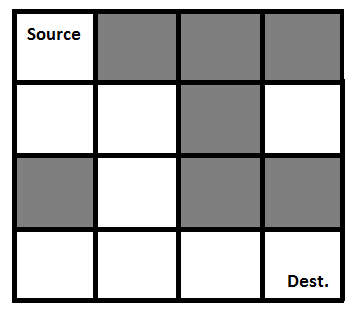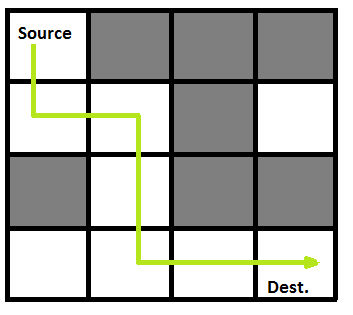A Maze is given as N*N binary matrix of blocks where source block is the upper left most block i.e., maze[0][0] and destination block is lower rightmost block i.e., maze[N-1][N-1]. A rat starts from source and has to reach destination. The rat can move only in two directions: forward and down.
In the maze matrix, 0 means the block is dead end and 1 means the block can be used in the path from source to destination. Note that this is a simple version of the typical Maze problem. For example, a more complex version can be that the rat can move in 4 directions and a more complex version can be with limited number of moves.
Following is an example maze.
Gray blocks are dead ends (value = 0).
Following is binary matrix representation of the above maze.
{1, 0, 0, 0}
{1, 1, 0, 1}
{0, 1, 0, 0}
{1, 1, 1, 1}
Following is maze with highlighted solution path.
Following is the solution matrix (output of program) for the above input matrx.
{1, 0, 0, 0}
{1, 1, 0, 0}
{0, 1, 0, 0}
{0, 1, 1, 1}
All enteries in solution path are marked as 1.
Solution. DFS Backtracking
1 import java.util.ArrayList; 2 public class Solution { 3 class Point{ 4 int x; 5 int y; 6 Point(int x, int y){ 7 this.x = x; 8 this.y = y; 9 } 10 void display(){ 11 System.out.println(Integer.toString(x) + "," + Integer.toString(y)); 12 } 13 } 14 public boolean findPath(int[][] maze, ArrayList<Point> path){ 15 if(maze == null || maze.length == 0 || maze[0].length == 0){ 16 return false; 17 } 18 int row = maze.length; int col = maze[0].length; 19 if(maze[0][0] == 0 || maze[row - 1][col - 1] == 0){ 20 return false; 21 } 22 return findPathRecursive(maze, path, 0, 0); 23 } 24 private boolean findPathRecursive(int[][] maze, ArrayList<Point> path,int x, int y){ 25 if(!isInBound(maze, x, y) || maze[x][y] == 0){ 26 return false; 27 } 28 path.add(new Point(x, y)); 29 if(x == maze.length - 1 && y == maze.length - 1){ 30 return true; 31 } 32 if(findPathRecursive(maze, path, x, y + 1)){ 33 return true; 34 } 35 if(findPathRecursive(maze, path, x + 1, y)){ 36 return true; 37 } 38 path.remove(path.size() - 1); 39 return false; 40 } 41 private boolean isInBound(int[][] maze, int x, int y){ 42 return x >= 0 && x < maze.length && y >= 0 && y < maze[0].length; 43 } 44 public static void main(String[] args){ 45 int[][] maze1 = {{1,0,0,0}, {1,1,0,1},{0,1,0,0},{1,1,1,1}}; 46 Solution sol = new Solution(); 47 ArrayList<Point> path = new ArrayList<Point>(); 48 sol.findPath(maze1, path); 49 for(Point p: path){ 50 p.display(); 51 } 52 } 53 }
Follow up question:
How many unique paths does this rat have to reach from source to destination?
This question is essentially identical with Unique Paths II.
Solution 1. Recursion
The rat can only move either downward or right, one grid at a time. Assume the start point is (x, y), then
this problem can be solved by first solving the following 2 subproblems.
1. find the number of all unique paths from (x + 1, y) to destination
2. find the number of all unique paths from (x, y + 1) to destination
However, this solution is not effiecient as it does a lot of duplicated work. For a given grid(x, y), it can be reached
either via (x - 1, y) or (x, y - 1). Both route calculates the number of all unique paths from (x, y) to the destination.
This is clearly redundant work. To avoid this inefficiency, we should use dynamic programming.
1 public class Solution { 2 private int totalPaths = 0; 3 public int uniquePathsWithObstacles(int[][] obstacleGrid) { 4 if(obstacleGrid == null || obstacleGrid.length == 0 || obstacleGrid[0].length == 0){ 5 return 0; 6 } 7 findPaths(obstacleGrid, 0, 0); 8 return totalPaths; 9 } 10 private void findPaths(int[][] grid, int x, int y){ 11 if(!isInBound(grid, x, y) || grid[x][y] == 1){ 12 return; 13 } 14 if(x == grid.length - 1 && y == grid[0].length - 1){ 15 totalPaths++; 16 return; 17 } 18 findPaths(grid, x + 1, y); 19 findPaths(grid, x, y + 1); 20 } 21 private boolean isInBound(int[][] grid, int x, int y){ 22 return x >= 0 && x < grid.length && y >= 0 && y < grid[0].length; 23 } 24 }
Solution 2. Dynamic Programming, O(n^2) runtime, O(n^2) space
State: T[j][k] is the total number of unique paths from (0,0) to (j, k)
Function: T[j][k] = 0, if obstacleGrid[j][k] == 1
T[j][k] = T[j - 1][k] + T[j][k - 1], if obstacleGrid[j][k] == 0
1 public class Solution { 2 public int uniquePathsWithObstacles(int[][] obstacleGrid) { 3 if(obstacleGrid == null || obstacleGrid.length == 0 || obstacleGrid[0].length == 0){ 4 return 0; 5 } 6 int[][] T = new int[obstacleGrid.length][obstacleGrid[0].length]; 7 int i = 0; 8 for(; i < obstacleGrid[0].length; i++){ 9 if(obstacleGrid[0][i] == 1){ 10 break; 11 } 12 T[0][i] = 1; 13 } 14 for(; i < obstacleGrid[0].length; i++){ 15 T[0][i] = 0; 16 } 17 i = 0; 18 for(; i < obstacleGrid.length; i++){ 19 if(obstacleGrid[i][0] == 1){ 20 break; 21 } 22 T[i][0] = 1; 23 } 24 for(; i < obstacleGrid.length; i++){ 25 T[i][0] = 0; 26 } 27 for(int j = 1; j < T.length; j++){ 28 for(int k = 1; k < T[0].length; k++){ 29 if(obstacleGrid[j][k] == 1){ 30 T[j][k] = 0; 31 } 32 else{ 33 T[j][k] = T[j - 1][k] + T[j][k - 1]; 34 } 35 } 36 } 37 return T[T.length - 1][T[0].length - 1]; 38 } 39 }
Solution 3. Dynamic Programming with optimzied space usage, O(n) space
1 public class Solution { 2 public int uniquePathsWithObstacles(int[][] obstacleGrid) { 3 if(obstacleGrid == null || obstacleGrid.length == 0 || obstacleGrid[0].length == 0){ 4 return 0; 5 } 6 int[][] T = new int[2][obstacleGrid[0].length]; 7 int i = 0; 8 for(; i < obstacleGrid[0].length; i++){ 9 if(obstacleGrid[0][i] == 1){ 10 break; 11 } 12 T[0][i] = 1; 13 } 14 for(; i < obstacleGrid[0].length; i++){ 15 T[0][i] = 0; 16 } 17 boolean reachable = (obstacleGrid[0][0] == 0 ? true : false); 18 for(int j = 1; j < obstacleGrid.length; j++){ 19 if(reachable && obstacleGrid[j][0] == 0){ 20 T[j % 2][0] = 1; 21 } 22 else{ 23 reachable = false; 24 T[j % 2][0] = 0; 25 } 26 for(int k = 1; k < obstacleGrid[0].length; k++){ 27 if(obstacleGrid[j][k] == 1){ 28 T[j % 2][k] = 0; 29 } 30 else{ 31 T[j % 2][k] = T[(j - 1) % 2][k] + T[j % 2][k - 1]; 32 } 33 } 34 } 35 return T[(obstacleGrid.length - 1) % 2][obstacleGrid[0].length - 1]; 36 } 37 }
Related Problems
Unique Paths
Unique Paths II

